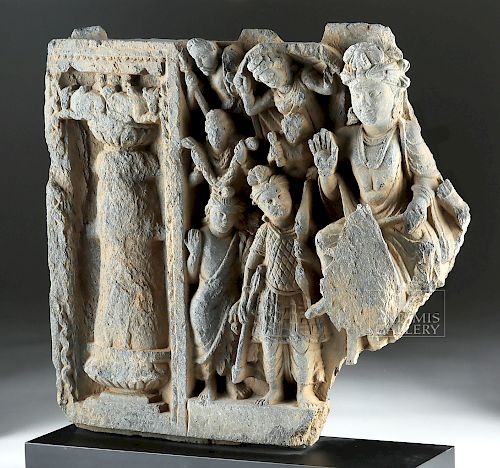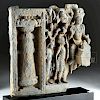2nd C. Gandharan Schist Frieze - The Great Departure
Lot 100a
About Seller
Artemis Fine Arts
686 S Taylor Ave, Ste 106
Louisville, CO 80027
United States
Selling antiquities, ancient and ethnographic art online since 1993, Artemis Gallery specializes in Classical Antiquities (Egyptian, Greek, Roman, Near Eastern), Asian, Pre-Columbian, African / Tribal / Oceanographic art. Our extensive inventory includes pottery, stone, metal, wood, glass and textil...Read more
Estimate:
$2,500 - $3,500
Absentee vs Live bid
Two ways to bid:
- Leave a max absentee bid and the platform will bid on your behalf up to your maximum bid during the live auction.
- Bid live during the auction and your bids will be submitted real-time to the auctioneer.
Bid Increments
| Price | Bid Increment |
|---|---|
| $0 | $25 |
| $300 | $50 |
| $1,000 | $100 |
| $2,000 | $250 |
| $5,000 | $500 |
| $10,000 | $1,000 |
| $20,000 | $2,500 |
| $50,000 | $5,000 |
| $100,000 | $10,000 |
| $200,000 | $20,000 |
About Auction
By Artemis Fine Arts
May 10, 2018
Set Reminder
2018-05-10 10:00:00
2018-05-10 10:00:00
America/New_York
Bidsquare
Bidsquare : Fine Ethnographic / Asian / Ancient Art
https://www.bidsquare.com/auctions/artemis-gallery/fine-ethnographic-asian-ancient-art-3213
Featuring antiquities from around the world including Pre-Columbian, Tribal, Classical, Asian, so much more! Artemis Fine Arts info@artemisgallery.com
Featuring antiquities from around the world including Pre-Columbian, Tribal, Classical, Asian, so much more! Artemis Fine Arts info@artemisgallery.com
- Lot Description
Ancient Near East, Pakistan and Afghanistan, Gandharan Empire, ca. 2nd to 3rd century CE. A large, hand-carved gray schist frieze depicting a scene from the early life of Buddha entitled, "The Great Departure." Here, we see Buddha (then Prince Siddhartha) on the right atop his horse about to abandon the comforts of his father's royal palace to seek enlightenment by becoming a mendicant, one who willingly chooses a life of begging and relies on the goodwill of others for survival. A myriad of attendants stands at his side holding gifts of silks, food, and medicines, with one holding a bow and arrow, all bestowed by the prince himself. A large column to the left features an ornate capital and is topped with a pair of stylized goats. Price Siddhartha is dressed in flowing robes, wears several large necklaces around his neck and an ornate turban atop his head, with his left hand grasping the reigns of his horse, and his right hand bestowing peace on his attendants. Size: 15.75" W x 14.75" H (40 cm x 37.5 cm); 16.875" H (42.9 cm) on included custom stand.
The story of the Great Departure takes places when Prince Siddhartha looks beyond the walls of his father's plush palatial estate. Upon seeing the destitute suffering of those outside the gates, the young prince begins to question why he should be so deserving of a life of ease and not have to endure the pains of everyday life experienced by those less fortunate than himself. The prince then vowed to leave the safety and security of his palace in order to obtain enlightenment and to teach himself a greater understanding of a world he had never known to exist. He left behind the totality of his former life, that being his family, money, clothing, and worldly possession save for his great white horse, Kanthaka.
This example depicts a scene at the palace just before the prince takes his leave. Just before he exits the premises of the palace, Prince Siddhartha gave away all of his worldly possessions to his loyal attendants including jewels, a bow and arrows, a fly whisk, and a parasol, among others. Once he began to make his way towards the gates of the palace, a gathering of dwarves (called "ganas") lifted the horse off of the ground so its hooves did not wake anyone in the palatial complex.
Provenance: private East Coast, USA collection
All items legal to buy/sell under U.S. Statute covering cultural patrimony Code 2600, CHAPTER 14, and are guaranteed to be as described or your money back.
A Certificate of Authenticity will accompany all winning bids.
We ship worldwide and handle all shipping in-house for your convenience.
#133410This was once part of a larger frieze. Surface wear commensurate with age as expected, with losses to horse head, noses of some figures, peripheries, and other high-pointed areas. Fading to some carved details and light discoloration, otherwise excellent. Light earthen deposits within recessed areas. Figural imagery still visible.Condition
- Shipping Info
-
All shipping is handled in-house for your convenience. Your invoice from Artemis Gallery will include shipping calculation instructions. If in doubt, please inquire BEFORE bidding for estimated shipping costs for individual items.
-
- Buyer's Premium



 EUR
EUR CAD
CAD AUD
AUD GBP
GBP MXN
MXN HKD
HKD CNY
CNY MYR
MYR SEK
SEK SGD
SGD CHF
CHF THB
THB

















